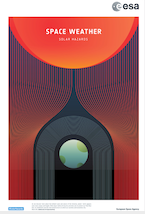Speaker
Description
A CubeSat constellation platform has been found to be a tempting and cost-effective solution for monitoring of space weather at LEO, which would complement higher altitude space weather observations, providing data for validation of space weather models and using assimilation for better spatial and temporal resolution, thus enabling services for operational use in aviation and other user sectors. A constellation of 10–20 CubeSats with continuous monitoring capability of solar X-ray fluxes and spectra, high-energy particles, and ionospheric electron density variability would be a suitable solution for such purpose.
There are already high-TRL solutions for space weather instruments adapted for CubeSats, like XFM-CS and high-energy particle monitors (Vainio et al., this workshop). Radio beacons and CubeSat platforms with high TRL are also available, and already in use for research of ionosphere, space weather and other purposes. We present an overview of a CubeSat constellation for space weather at LEO, including the platform, payload, and the ground segment, and discuss the use of the data from the system for new space weather services.
Isaware develops instruments for space weather observations in collaboration with ESA, industrial companies and scientific institutions. The first instrument, X-ray Flux Monitor for CubeSats (XFM-CS) has been developed in a tightly scheduled project in 1.5 years and will be integrated with a CubeSat manufactured by Reaktor Space Lab and ready for launch in 2020 in the SUNSTORM 1 mission. XFM will observe the X-ray spectrum of the Sun, and provide X-ray flux data compatible with that of GOES X-ray flux monitors, thus serving as an alert device of solar flares, but will also provide high spectral and time resolution X-ray spectra for refined analysis of solar flares, and for investigations of ionospheric effects on Earth. A next, radiation hardened version of the XFM is being developed for the in-situ instrument suite of the Lagrange 5 mission of ESA.

